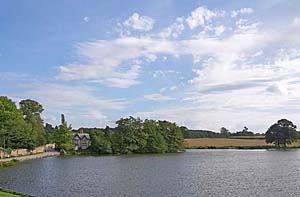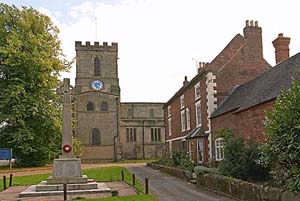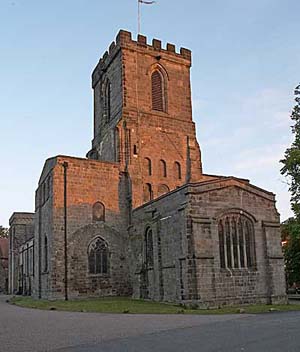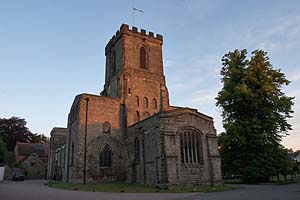Melbourne is a small Derbyshire town, with about 4000 inhabitants, known chiefly for its market gardens and shoe manufacture, though other small industries exist and it has an industrial estate.
Between the wars there were about 60 growers of fruit and vegetables in Melbourne. By 1980 this number had fallen to around 20. Now only a handful are in the business. However at least as much land in the locality is devoted to market gardening as it ever was, but less of it in Melbourne itself. You have to look to the surrounding villages like Weston on Trent, Barrow and Swarkestone to find where much of the intensive market gardening goes on. Much of the area around Melbourne is now more conventional farmland.

Melbourne in Derbyshire |

Melbourne |

Melbourne in Derbyshire |

Melbourne |
Melbourne has several churches, chapels, a school, shops, pubs and a large Hall with pool.
The church of St Michael with St Mary is on the site of a much earlier Anglo Saxon building, and is regarded as one of the finest Norman Parish Churches in the country. It is mostly 12th century, with some later additions. It was built as a retreat for the Bishops of Carlisle, who were under constant threat of raids and violence in their northern parish.
The church possesses a 2 tower facade, unique amongst Norman parish churches, a crossing tower, a nave of 5 bays, aisles and transepts. All of this is Norman with the exception of the Perp aisle windows and Perp east windows, due to the alteration of the chancel which originally ended in an apse. It contains alabaster slabs to Henry Hardie, who died in 1613, Anne Harding, who died in 1673 and Sir Robert Harding, who died in 1679.
Melbourne once had its own castle, a large structure with many towers. It was dismantled in 1460 after falling into disrepair, and now only a single wall stands behind Castle Farm, a partly 17th century brick house. John, Duke of Bourbon, who was the most important prisoner taken at Agincourt, was detained in the castle for 19 years.
Melbourne Hall is open to the public during the month of August each year, excluding mondays. It was built as a rectory for the Bishops of Carlisle who leased it to Sir John Coke in 1628. He acquired the freehold and subsequent generations of the family have altered and enlarged the hall and gardens. Recent residents have been Lord and Lady Ralph Kerr, son and daughter in law of the 12th Marquis of Lothien. The gardens contain a wonderfully ornate, wrought iron arbour, built by Robert Bakewell, and known locally as the birdcage. Robert Bakewell lived in Melbourne for a time in what was then the Tythe Barn Cottage, now reverted to its old nameof The Old Stone House. He lived with the widow Fisher and her daughters until one daughter became noticeably pregnant and he found it expedient to move hurriedly to Derby, where he spent the rest of his life.
Melbourne has a strong musical tradition with a highly esteemed operatic society as well as a male voice choir. There was also a Melbourne Town band formed in 1993.
The travel magnate Thomas Cook was born in Melbourne in 1808, and started his business here at an early age, selling train excursions and taking a percentage of the railway tickets sold.The Thomas Cook Memorial Cottages in High Street were built by Cook though his own birthplace was demolished in 1968. The cottages provide accommodation for some of Melbourne's senior citizens.
Melbourne Market Place is the location of Melbourne's main shops, including the Co-op building and monument which was refurbished in 1998.
More information on Melbourne Hall at Melbourne Hall and Gardens